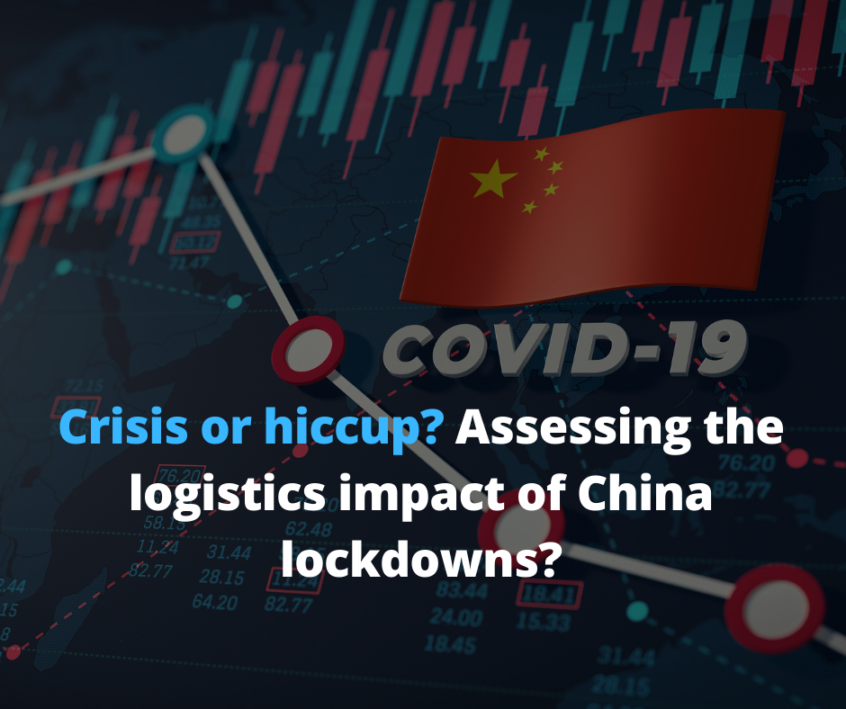
Amidst the new lockdowns in China, some experts wonder whether the termination of quarantine regulations will lead to an over-demand for cargo shipping, transportation, and logistics. Currently, airfreight is also experiencing some of the negative effects of quarantine. Shanghai has become an epicenter of slowed trade as the new outbreak threatens many businesses.
Different circumstances and timeframes lead to divergent narratives about the impact of the COVID-19 restrictions and the eventual easing of those restrictions. For example, some warn that the eventual easing of restrictions will cause supply chain gridlock. Perhaps, this discussion remains a moot point since there are currently no signs that the Shanghai lockdown is about to be eased. Nevertheless, the perceptions of industry experts and affected businesses are important. It is important to understand the key mechanisms and events of the latest shutdown as a starting point.
Key mechanisms and events in the shutdown
Much information about the lockdown and its effects is being shared on social media. We have seen steel fences being installed on public roads. There are also images of residential compounds being closed off to prevent people from traveling to other districts or even changing locations. The Shanghai Health Commission recently reported nearly 2500 new cases on 2nd May 2022, nearly a two-fold increase from the previous day. More than 50 people died that day. The totality of cases in the latest wave has now exceeded 30,000.
COVID-19 cases are rising in Beijing and have somewhat dampened the encouraging news of easing restrictions including Guangzhou. The worry is that other areas could soon join Suzhou and Shanghai in having to implement a preventative lockdown. Already, important business hubs in Shanghai are continuing the shutdown. For example, Kunshan, a manufacturing hub located to the west of Shanghai, has decided to extend the lockdown, which started on the 2nd of April 2022. Indeed, several Hangzhou districts central to e-Commerce giants like Alibaba have been in lockdown since the 23rd of April 2022. Mass testing was ordered for nearly half a week. The worry is about what happens when restrictions are eased.
The restrictions are expected to ease around the Middle of May 2022
Although there is uncertainty in the shipping industry, analysts have indicated that current trends would herald an easing of lockdown measures around the middle of May or even June. Meanwhile, the Chinese government is likely to maintain the Zero COVID policy if there are infections. To some extent, the logistics challenges may be manageable, at least in the short run. For example, the Port of Shanghai remains open, which is significant because it is the largest container shipping gateway globally.
Even the delays in Shanghai are no more than 48 hours. Indeed, the 12 days it is currently taking to pick up an import box is more promising than the dire waits that were experienced in the first wave of the COVID-19 pandemic. Moreover, the number of vessels waiting for a berth has reduced since the start of the latest lockdown. Additionally, there is only limited congestion arising from cargo redirected from other ports. The problem with such optimism is that it does not fully account for deferred cargo that may be piling up during the lockdown.
Preparing for an influx of cargo when lockdown measures are eased
Experts worry that there is a lot of unprocessed cargo lying in warehouses and not being reflected in current statistics. For example, some factories are now working overtime to compensate for the lost capacity from the pandemic and the latest lockdown. One of the reasons we are not seeing epic queues is that the zero-COVID policy is restricting many truck drivers. While these drivers are not moving around Shanghai, the backlog is building up. Experts have expressed concern that a significant wave of cargo will overwhelm the supply chain once the restrictions are eased.
The handling capacity of overseas and local ports has not been expanded during this lull. This means that the traditional peak shipping season will face even more pressure than before. Those shippers that are yet to place their orders may not get deliveries on time for big shopping events, such as Halloween, back-to-school, and the Christmas season. Michael Zimmerman of Kearney argues that the shipping industry is being materially disrupted. So, for example, in 2021, six weeks were required to return to parity for every week of a shutdown. Because we are now in the third week of the latest shutdown, it is realistic to expect a recovery timescale of at least three months. Economic dynamics underpin all this.
The economic implications of the shutdown revisited
The latest reports indicate that the industrial output in Shanghai has fallen by about 7.5% in March 2022. This is backed by a fall in manufacturing output and restricted truck access to the airport and port. Hence, the ocean export volumes are deteriorating in the area. Because of a slowdown in imports, getting important raw materials to the manufacturers is increasingly difficult. As a result, many companies are either operating at low levels or have shut down. Any export-oriented business in China relies significantly on imported raw materials, which are now unavailable until restrictions have eased.
One of the significant risks is that automotive, technology, and industrial companies in Kunshan and Shanghai will have to halt their operations when they run short of components. This risk will be heightened if the restrictions continue well into May 2022. We already know that at least 11 Apple suppliers have reported sub-optimal productivity following the lockdown, according to reports by Everstream. Indeed, Foxconn, a key Apple supplier, halted production at its plants in Kunshan and Shanghai. The recent re-opening instructions have done little to stem the tide.
So far, re-opening is not making things better for Shanghai
Even when the authorities allowed 660 companies to restart their operations last week, workers were still being prevented from getting to their respective places of employment, meaning that attendance is down to only 50%. Productivity at the Shanghai port has fallen by as much as 30%, and some carriers are simply skipping the port. The delays negatively impact intra-Asia trades, European lanes, and North American logistics. This has the potential to become as bad as when the Yantian terminal in Shenzhen went under quarantine in 2021, and productivity fell by four-fifths. At least at the time, the restrictions were on one port and not the entire city.
The crisis has been reflected in the blank sailings that Maersk announced on Monday for the AE1 service to Ningbo. The official explanation was the accumulating bottlenecks plaguing the Asia-North European lines. Hence, Maersk is re-routing cargo whenever an opportunity arises. Another option is to adjust rail and barge capacities as a response to landside challenges. The Alliance (ONE, Hapag-Lloyd, and Yang Ming) has followed suit by canceling 36 voyages that were scheduled for Shanghai. There are severe shortages of 40-foot containers. Those that rely on 20-footers are exploring alternative Chinese ports other than Shanghai. The suspension of critical services remains a worry.
Major carriers start mitigation plans that involve suspensions and drawdowns
Several carriers such as CMA CGM, Hapag-Lloyd, and ONE no longer accept dangerous or refrigerated cargo to Shanghai since they are short of storage in Shanghai. Even though Maersk resumed dangerous goods bookings at Shanghai on Friday, the yard density is only slowly improving. Ocean demand for out-of-China ports to the US dropped by about a third between the 6th and 15th of April 2022. Other factors may be at play, including the fall in consumer demand as US retail sales are down when compared to 2021, with inflation squeezing wallets and many prioritizing services spending.
The airports are also facing new capacity challenges with rapidly changing logistics dynamics. From the beginning of March 2022, inbound freight has experienced delays of anywhere from 10 to 20 days. This is because of airport customs closures in Shanghai that emanate from quarantine rules. Reports indicate that outbound volumes are also falling, although there is an expectation that airfreight will recover once the lockdown is eased. Courier services will take much longer to recover, even with the easing of restrictions.
Wrapping up
Overall, the zero-COVID policy being applied in Shanghai makes it difficult to understand the long-term effects on shipping and logistics. On the one hand, there is an expectation that easing the restrictions will allow for a quick recovery. On the other hand, there is a worry that an ongoing backlog will overwhelm the logistics sector once restrictions have eased. In any case, the expected easing of restrictions in May or June 2022 should provide a clearer picture


